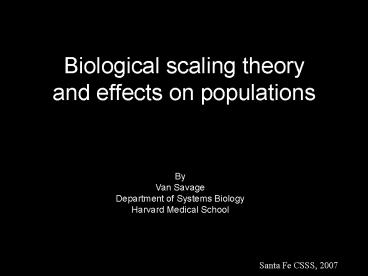Biological scaling theory and effects on populations - PowerPoint PPT Presentation
1 / 32
Title:
Biological scaling theory and effects on populations
Description:
Theory for dependence of biological rates, times, and lengths on body size ... Many other unicells, insects, and zooplankton are a good ... – PowerPoint PPT presentation
Number of Views:47
Avg rating:3.0/5.0
Title: Biological scaling theory and effects on populations
1
Biological scaling theoryand effects on
populations
By Van Savage Department of Systems
Biology Harvard Medical School
Santa Fe CSSS, 2007
2
Outline
- Theory for dependence of biological rates, times,
- and lengths on body size
- 2. Dependence for biological rates on body
temperature - 3. Scaling or population growth
- 4. Scaling of species interactions
(predator-prey) - 5. Conclusions
3
Savage, et al., Func. Eco., 2004
4
3/4-power scaling
Number of Rates with Exponent
Scaling Exponent
Rates at the cellular, individual, and population
level for many different taxa scale like this.
Many times and lengths also scale.
Savage et al., Func. Eco., 2004 Peters,
Ecol. Implications of Body Size, (1983)
5
Theory for body mass scaling
6
Theory has three assumptions
- i. Branching, hierarchical network that is space
filling to feed all cells
ii. Minimization of energy to pump blood from
the heart to the capillaries
iii. Capillaries are invariant in size
West et al. Science (1997)
7
Hierarchical, Branching Network
Level 2
Level 1
Level 0
Level 2
8
i. Space filling
9
Space filling
10
Space filling
11
Space Filling
12
ii. Minimize energy loss (selection)
Reflection at junctions (Important for larger
vessels, pulsatile flow)
13
Body Size Changes Network Size
Capillaries
Aorta
Level 0
level
Level 1
Terminal units are invariant.
14
Metabolic Rate, B, and Body Mass, M
Number of Terminal units
Volume of Terminal units
Blood volume
Met Rate
Mass
Follows from Energy Min.
Use scale factors to relate each level to
terminal units.
Invariance of terminal units BNTBT
West et al. Science (1997)
15
Theory has three assumptions
- Branching, hierarchical network that is space
filling to feed all cells-gtrelates vessel lengths
across levels of cardiovascular system - Minimization of energy to send vital resources to
the terminal units (pump blood from the heart to
the capillaries)-gtrelates vessel radii across
levels of cardiovascular system and connects
blood volume to body size - Capillaries are invariant in size-gtsets overall
scale for cardiovascular system
Together these determine the scaling for the
network.
16
Theory for body temperature biochemical reaction
kinetics
Changes energy of impact and frequency of
collisions,
17
Characteristic Biological Rates and Times
15 orders of magnitude collapses to 1 order of
magnitude variation! Zeroeth-order model for
quantifying differences between organisms and
identifying other relevant parameters.
Gillooly, Charnov, West, Savage, and Brown Nature
(2002).
18
Temperature Dependence of Metabolic Rate
Similar slopes reflect similar activation
energies and shared biochemistry through
evolution. M and T explain dominant variation.
Gillooly, Brown, West, Savage, and Charnov
Science (2001)
19
Mass and Temperature Dependence of Lifespan
Gillooly, West, Brown, Savage, and Charnov
Science (2001)
20
An AnacreontickBusy, curious, thirsty
Fly,Gently drink, and drink as IFreely welcome
to my Cup,Could'st thou sip, and sip it upMake
the most of Life you may,Life is short and wears
away.Just alike, both mine and thine,Hasten
quick to their DeclineThine's a Summer, mine's
no more,Though repeated to threescoreThreescore
Summers when they're gone,Will appear as short
as one.By William Oldys
21
Population Level
22
Population Growth From Individuals To
Populations
or
-per absolute time, not per generation
Savage et al. Am. Nat. 2004
23
Eulers Equation (for positive growth)
-Survivorship and fecundity are also
important, and can make that explicit!
-gt
N(t) is population size at time t r is rate of
increase, fundamental variable B(t) is number of
births at time t l(x) is probability of
survivorship up to age x b(x) is fecundity rate
at age x
Savage et al. Am. Nat. 2004
24
Discrete Generations
NB(x)
Organisms reproduce once in their lifetime
.
NB(x) is cumulative number of
offspring at age x
NB(G)
G is the generation time and is the average
age at which an organism has offspring
x
G
Univoltine insects follow this exactly Many other
unicells, insects, and zooplankton are a good
approximation to this Savage et al., Am. Nat.,
2004.
Empirical M dependenceFenchel (1973), Southwood
et al. (1974), May (1976), Blueweiss et al.
(1978) Empirical T dependenceMonod (1942),
Birch (1948), Hinshelwood (1966), Droop(1968),
Eppley (1972)
25
Intrinsic Rate of Increase
Savage et al. Am. Nat. 2004
26
Overlapping Generations
b(x), l(x)
Mortality Rate
b(?)
l(?)
x
Age at 1st Reproduction
?
Size and temperature do not affect the percentage
of offspring that survive to the age of first
reproduction.
Savage et al., Am. Nat, 2004
27
Time to First Reproduction, ?Measure of
Development
Gillooly, Charnov, West, Savage, and Brown Nature
(2002).
28
Little Variation Across Broad Assortment of
Organisms
Savage et al. Am. Nat. 2004
29
Mortality Rates in the Field
Savage et al. Am. Nat. 2004
Data from Pauly (1980)
30
Scaling of Population Size
Assume fixed amount of resources P
At steady state, dN/dt0, population is at
carrying capacity for environment, K(M,T)
With energy equivalence, Damuth, Bio. J. Lin.
Soc. (1987), this holds for multiple populations
in a shared environment
Savage et al. Am. Nat. 2004
31
Physics Science is mathematical not because we
know so much about the physical world, but
because we know so little it is only its
mathematical properties that we can discover.
Bertrand Russell
32
Conclusions
- 1. Power laws are common in biology (and
elsewhere) - 2. Dynamical model based on distribution of
resources - makes many predictions that match data.
- 3. Temperature also affects biological rates and
times - and can include this effect
- 4. Can build up from one level to the next to
understand - population growth (but ants)
- 5. Species interactions and competition can begin
to - be incorporated into both scaling and models of
effects - of climate change on biological systems.































